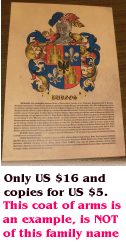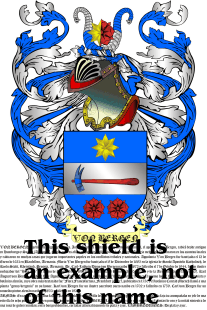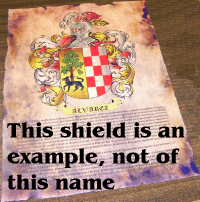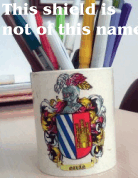
Parchment with the coat of arms, origin and history for the family name Aspilaga. Very cheap.

Coat of arms for Aspilaga and the history and origin for the family name Aspilaga in JPG or Vectorial files as Corel-Draw, AI, WMF, etc.
That the last name Aspilaga is in "El Solar Vasco Navarro" by the Garcia Carraffa brothers means that the Aspilaga are of Basque, Navarre, or other origin but settled in the Basque Country and / or Navarre. The Basque family names were formed taking into account the names of the places, and the personal ones varied in each generation and even between brothers. It was customary to take the name of the lot to demonstrate ownership over it. The name of the plants, rivers, mountains, forests, rocks, fields served as inspiration. You can distinguish terms, as the meaning of the colors or pieces that make up the coats of arms, to have the nobiliary historical information of the family name Aspilaga, to know the fights of nobility of the Aspilaga, income to military orders, to know about the nobility titles that may have the persons with the last name Aspilaga, honorary offices or public offices of the Aspilaga.
It may be helpful for those with the name Aspilaga to know that, in the 15th century, hereditary surnames are already more or less consolidated, thanks in part to the obligation (at the initiative of Cisneros) to record births and deaths in parish books. In any case, it is important to know that, especially in rural areas and among the most humble people, the current norm of the hereditary paternal surname is not fixed definitively until the 19th century, topic that should be taken into account if it is applicable to some families of the family name Aspilaga It is due to spelling errors and of different types that there are different spellings of the same family name, so those of the name Aspilaga can have graphic variants.
One of the most distinctive qualities of heraldry is the use of a limited palette of colours and patterns, usually referred to as tinctures. These are divided into three categories, known as metals, colours, and furs.
Next we are going to see the meanings of three tinctures:
1) GULES: Red color that symbolizes Strength, Victory, Daring and Highness.
2) SABLE: Black color that symbolizes Prudence, Sadness, Rigor, Honesty and Obedience.
3) ARGENT (Silver): Purity, Integrity, Obedience, Firmness, Surveillance, Eloquence and Expiration.
Next lets look at the characteristics of some figures that we can find in heraldry and crests:
* FIG: The Fig Tree or its leaves symbolize the State Benefactors.
* FUSIL: The Fusil is a symbol of Righteousness, Prudence and Equity and of the conveniences achieved through these virtues; it serves as a hieroglyph for those who gathered many goods using lawful and upright means.
* WINDMILL: The Windmills and their Wheels are a symbol of Obedience, because they face the violence of the current and obey the movement that it prints.
* PIGEON: The Pigeon is a symbol of Health; in the coat of arms it denotes Fidelity and Love. It is the emblem of the Third Person of the Holy Trinity and, as such, adorns the currency of the French Order of the Holy Spirit.
* WHEEL: The Wheels symbolize Speed in carrying out the most arduous undertakings. They are also a symbol of Fortune, Favor and Inconstancy.
* ANCHOR: The Anchor is a symbol of Hope, it also means security and constancy, even in the greatest setbacks of fortune.
* STAG: The Stag symbolizes Effortless Courage, which draws and recovers energy even on the most adverse occasions.
* CHEVRON: The Chevron symbolizes the boots and spurs, and for this reason it was granted as an adornment of the shield to the Knight who was wounded from the combat in his legs.
* The family name Aspilaga appears in the list of last names of Heraldry & Crests so its complete history, crest and coat of arms or heraldic shields can be known on his website: http://www.heraldrycrests.com/
Heraldry for family name Aspilaga as well as its history is at your disposal here: Heraldry, history, origin, crest and coat of arms of the family name Aspilaga
Related Words: Aspilaga family crest | Origin of the name Aspilaga | Genealogy of the family Aspilaga | Heraldry of the name Aspilaga | Coat of arms of Aspilaga | Genealogy of the Aspilaga | Origin of the Aspilaga | Meaning of the name Aspilaga.

All the information about the surnames that are collected in this web site are based on verified bibliography.
Origin of family name, history and coat of arms/crests

